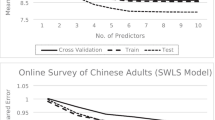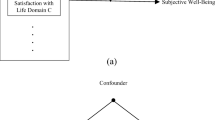Abstract
In subjective well-being (SWB) studies, domain importance typically refers to the relative importance of various life domains. Although there appears to be a consensus that domain importance is an important topic, whether or not domain importance should be incorporated into measures of SWB remains contentious. Even though recent studies that examined the claims against incorporating domain importance, also known as domain importance weighting, into SWB measures found that both conceptual and empirical arguments have been far from sufficient, insufficient evidence against importance weighting does not mean there is evidence to support importance weighting. Conducting a secondary analysis, the current study investigates the role of domain importance in SWB measures without making any arbitrary assumptions regarding how domain importance weighting should function. Results of the study show that the relationship between global life satisfaction and the sum of domain satisfaction scores did not remain constant across groups of different domain importance rating patterns. The findings suggest that, when the research objective is to study variability of responses at the level of homogeneous subgroups, it is important to consider domain importance when using domain satisfaction to construct global SWB measures.
Similar content being viewed by others
References
Aldenderfer, M. S., & Blashfield, R. K. (1984). Cluster analysis. Beverly Hills, CA: Sage.
Bergman, L. R., & Magnusson, D. (1997). A person-oriented approach in research on developmental psychopathology. Development and Psychopathology, 9, 291–319.
Campbell, A., Converse, P. E., & Rodgers, W. L. (1971). Quality of American Life, 1971 (Ann Arbor, MI: Inter-university Consortium for Political and Social Research [distributor], 1992-02-16. doi:10.3886/ICPSR03508.v1).
Campbell, A., Converse, P. E., & Rogers, W. L. (1976). The quality of American Life: Perceptions, evaluations, and satisfactions. New York: Russel Sage.
Cummins, R. A. (1995). On the tale of gold standard for life satisfaction. Social Indicators Research, 35, 179–200.
Cummins, R. A. (1996). The domains of life satisfaction: An attempt to order chaos. Social Indicators Research, 38, 303–328.
Ferrans, C. E. (1990). Development of a quality of life index for patients with cancer. Oncology Nursing Forum, 17(3), 15–19.
Ferrans, C., & Powers, M. (1985). Quality of life index: Development and psychometric properties. Advances in Nursing Science, 8, 15–24.
Frisch, M. B., Cornell, J., Villanueva, M., & Retzlaff, P. J. (1992). Clinical validation of the Quality of Life Inventory: A measure of life satisfaction for use in treatment planning and outcome assessment. Psychological Assessment, 4, 92–101.
Hagerty, M. R., Cummins, R. A., Ferris, A. L., Land, K. C., Michalos, A. C., Peterson, M., et al. (2001). Quality of life indexes for national policy: Review and agenda for research. Social Indicators Research, 55, 1–96.
Hagerty, M. R., & Land, K. C. (2007). Constructing summary indices of quality of life: A model for the effect of heterogeneous importance weights. Sociological Methods and Research, 35, 455–496.
Hsieh, C. M. (2003). Counting importance: The case of life satisfaction and relative domain importance. Social Indicators Research, 61, 227–240.
Hsieh, C. M. (2004). To weight or not to weight: The role of domain importance in quality of life measurement. Social Indicators Research, 68, 163–174.
Hsieh, C. M. (2012a). Importance is not unimportant: The role of importance weighting in QoL measures. Social Indicators Research, 109, 206–278.
Hsieh, C. M. (2012b). Should we give up domain importance weighting in QoL measures? Social Indicators Research, 108, 99–109.
Hsieh, C. M. (2013). Issues in evaluating importance weighting in quality of life measures. Social Indicators Research, 110, 681–693.
Hsieh, C. M. (2014). Throwing the baby out with the bathwater: Evaluation of domain importance weighting in quality of life measurements. Social Indicators Research, 119, 483–493.
Hsieh, C. M., & Kenagy, G. P. (2014). Measuring quality of life: A case for re-examining the assessment of domain importance weighting. Applied Research in Quality of Life, 9, 63–77.
Inglehart, R. (1978). Value priorities life satisfaction, and political dissatisfaction among western publics. Comparative Studies in Sociology, 1, 173–202.
Locke, E. A. (1969). What is job satisfaction? Organizational Behavior and Human Performance, 4, 309–336.
Locke, E. A. (1976). The nature and causes of job satisfaction. In M. D. Dunnette (Ed.), Handbook of industrial and organizational psychology (pp. 1297–1349). Chicago: Rand McNally.
Magidson, J., & Vermunt, J. (2002a). Latent class cluster analysis. In J. A. Hagenaars & A. L. McCutcheon (Eds.), Applied latent class analysis (pp. 89–106). Cambridge: Cambridge University Press.
Magidson, J., & Vermunt, J. K. (2002b). Latent class models for clustering: A comparison with K-means. Canadian Journal of Marketing Research, 20, 37–44.
Magidson, J., & Vermunt, J. K. (2004). Latent class models. In D. Kaplan (Ed.), Sage handbook of quantitative methodology for social sciences (pp. 175–198). Thousand Oaks, CA: Sage.
Mastekaasa, A. (1984). Multiplicative and additive models of job and life satisfaction. Social Indicators Research, 14, 141–163.
McCutcheon, A. L. (2002). Basic concepts and procedures in single- and multiple-group latent class analysis. In J. A. Hagenaars & A. L. McCutcheon (Eds.), Applied latent class analysis (pp. 56–85). Cambridge: Cambridge University Press.
Milligan, G. W., & Cooper, M. C. (1985). An examination of procedures determining the number of clusters in a data set. Psychometrika, 50, 159–179.
Milligan, G. W., & Cooper, M. C. (1987). Methodology review: Clustering methods. Applied Psychological Measurement, 11, 329–354.
Muthén, B. O. (2001). Latent variable mixture modeling. In G. A. Marcoulides & R. E. Schuniaker (Eds.), New developments and techniques in structural equation modeling (pp. 1–33). Mahwah, NJ: Lawrence Erlbaum.
Nylund, K. L., Asparouhov, T., & Muthén, B. O. (2007). Deciding on the number of classes in latent class analysis and growth mixture modeling: A Monte Carlo simulation study. Structural Equation Modeling, 14, 535–569.
Philip, E. J., Merluzzi, T. V., Peterman, A., & Cronk, L. B. (2009). Measurement accuracy in assessing patient’s quality of life: To weight or not to weight domains of quality of life. Quality of Life Research, 18, 775–782.
Rojas, M. (2006). Life satisfaction and satisfaction in domains of life: Is it a simple relationship? Journal of Happiness Studies, 7, 467–497.
Russell, L. B., & Hubley, A. M. (2005). Importance ratings and weighting: Old concerns and new perspectives. International Journal of Testing, 5, 105–130.
Russell, L. B., Hubley, A. M., Palepu, A., & Zumbo, B. D. (2006). ‘Does weighting capture what’s important? Revisiting subjective importance weighting with a quality of life measure. Social Indicators Research, 75, 146–167.
Ryff, C. D., & Essex, M. J. (1992). The interpretation of life experience and well-being: The sample case of relocation. Psychology and Aging, 7, 507–517.
Snedecor, G. W., & Cochran, W. G. (1989). Statistical methods. Ames, IA: Iowa State University Press.
Trauer, T., & Mackinnon, A. (2001). ‘Why are we weighting? The role of importance ratings in quality of life measurement. Quality of Life Research, 10, 579–585.
Vermunt, J. K., & Magidson, J. (2013). Latent GOLD 5.0 upgrade manual. Belmont, MA: Statistical Innovations Inc.
Ward, J. H. (1963). Hierarchical grouping to optimize and objective function. Journal of the American Statistical Association, 58, 236–244.
Wu, C. H. (2008a). Examining the appropriateness of importance weighting on satisfaction score from range-of-affect hypothesis: Hierarchical linear modeling for within-subject data. Social Indicators Research, 86, 101–111.
Wu, C. H. (2008b). Can we weight satisfaction score with importance ranks across life domains? Social Indicators Research, 86, 468–480.
Wu, C. H., Chen, L. H., & Tsai, Y. M. (2009). Investigating importance weighting of satisfaction scores from a formative model with partial least squares analysis. Social Indicators Research, 90, 351–363.
Wu, C. H., & Yao, G. (2006a). Do we need to weight item satisfaction by item importance? A perspective from Locke’s range-of-affect hypothesis. Social Indicators Research, 79, 485–502.
Wu, C. H., & Yao, G. (2006b). Do we need to weight satisfaction scores with importance ratings in measuring quality of life? Social Indicators Research, 78, 305–326.
Wu, C. H., & Yao, G. (2007). Importance has been considered in satisfaction evaluation: An experimental examination of Locke’s range-of-affect hypothesis. Social Indicators Research, 81, 521–541.
Zabinski, M. F., Norman, G. J., Sallis, J. F., & Calfas, K. J. (2007). Patterns of sedentary behavior among adolescents. Health Psychology, 26, 113–120.
Author information
Authors and Affiliations
Corresponding author
Rights and permissions
About this article
Cite this article
Hsieh, Cm. Domain Importance in Subjective Well-Being Measures. Soc Indic Res 127, 777–792 (2016). https://doi.org/10.1007/s11205-015-0977-7
Accepted:
Published:
Issue Date:
DOI: https://doi.org/10.1007/s11205-015-0977-7




